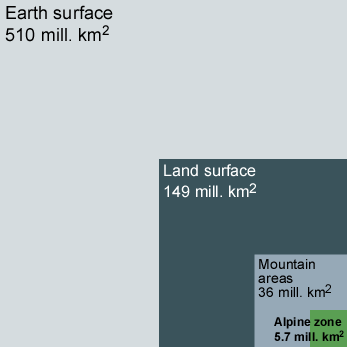 |
|
|
|
|
|
|
Aerial extent |
|
About 24% of the Earth's land surface or 35.8 million km2 are covered by mountains. The extent of the alpine zone is much smaller with about 5.7 million km2 or nearly 4.5% of the terrestrial surface. About 30% of this area is covered by glaciers, mountain deserts or otherwise bare of any vegetation. The remaining 70% or 3% of the global land area are covered by some sort of alpine vegetation. Although this area appears relatively small, it is inhabited by roughly 10 000 species of higher plants. This high species diversity indicates that mountains are important for biodiversity and endemism. |
1 - Comparison of areas |
|
Economical importance About 10% of the world's population live in mountain regions, but only few are inhabitants of the alpine belt. Yet, natural hazards originating in the alpine zone may reach far below. Thus the stability of the alpine environment is of importance also for those living outside the alpine zone. The alpine zone is of great economical value for agriculture and especially pasturing, and of increasing importance for leisure activities. Mountains are of particular importance for hydrological cycles. They intercept precipitation and thus play a key role for clean and steady discharge and limiting flooding. It has been estimated that about 40% of all humans depend in some way on mountain resources, especially on drinking water and irrigation water yielded by high altitude catchments. |
|
Vulnarability Various aspects of the alpine envrionment like the cold climate and thus slow development of soil and vegetation, permafrost, and high kinetic energy, make it a particlularly sensitive zone to global change. It can be expected that consequences of global change can be observed in the alpine zone and it may have disastrous consequences. |
29 August 2011 |
||
| |
||
